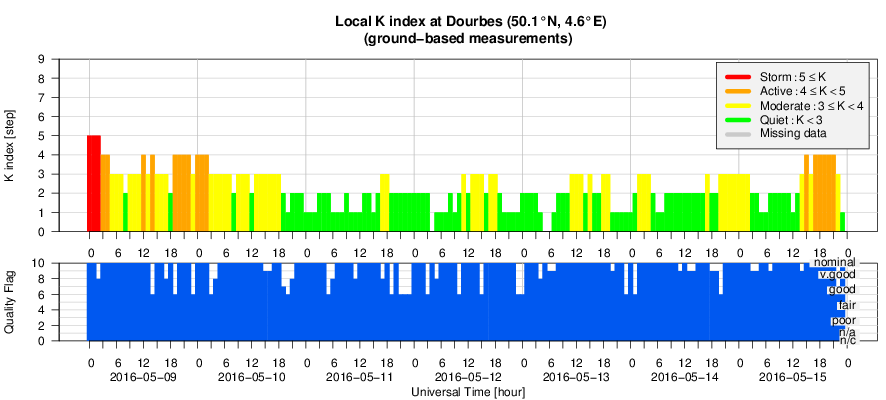- Table of Content
- 1.An early appli...
- 2.Data Homogenis...
- 3.PROBA2 Observa...
- 4.Review of sola...
- 5.The Internatio...
- 6.Review of geom...
- 7.Geomagnetic Ob...
- 8.Review of iono...
- 9.Future Events
- 10.New documents ...
2. Data Homogenisation workshop in Brussels
3. PROBA2 Observations (9 May 2016 - 15 May 2016)
4. Review of solar activity
5. The International Sunspot Number
6. Review of geomagnetic activity
7. Geomagnetic Observations at Dourbes (9 May 2016 - 15 May 2016)
8. Review of ionospheric activity (9 May 2016 - 15 May 2016)
9. Future Events
10. New documents in the European Space Weather Portal Repository
An early application...
We are still far from the year's end, yet we already received an application for the most impressive solar event of the year. A relatively modest C3 flare near the small sunspot group NOAA 2542 turned out to be very impressive in imagery taken in the more energetic EUV (extreme ultraviolet) passbands. Lasting 2 hours and 14 minutes, it was also a long duration event. An enhancement in the energetic particle flux was observed, but the proton event threshold was not reached.
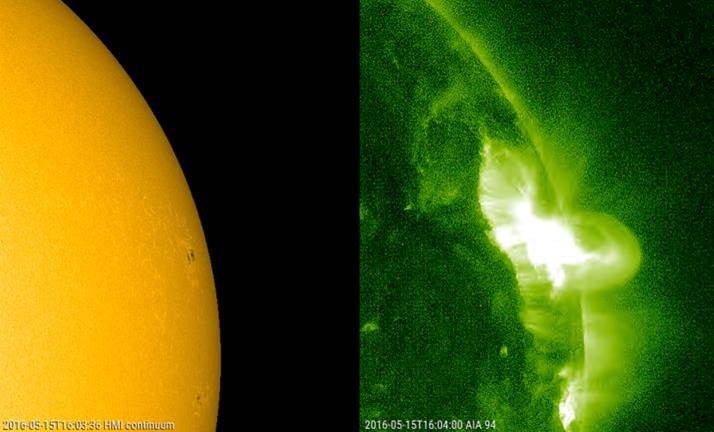
This event pretty much got it all. Double ribbon flare, arcade (series of post-flare coronal loops), coronal dimming, supra-arcade downflows,... the list is long with this one! There was also a partial halo associated with it, but not directed to Earth. Above a picture near the x-ray peak (16:03UT) in white light (SDO/HMI; about 6000 degrees; "solar surface") and in EUV (SDO/AIA 094; "corona" or hot outer solar atmosphere) at a temperature of several million degrees. Underneath (16:55UT) a comparison of the lower atmosphere of the Sun (AIA 304; around 80.000 degrees) again to the "hot" AIA 094.
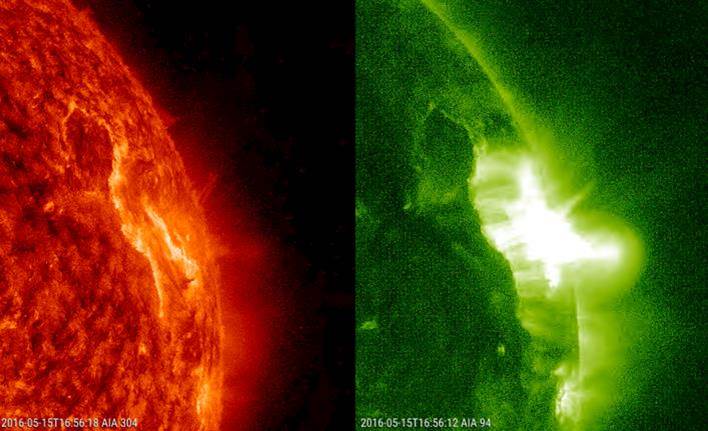
A movie at https://youtu.be/omlRG1xzRaE was compiled in which images from the various passbands are compared to each other. The movie ends with a comparison of all 4 EUV passbands: in one clip they are nicely separated from each other, in the other clip they are combined (one image layer on top of the other). Besides the AIA 304 and AIA 094 images, also AIA 171 (temperatures around 700.000 degrees) and AIA 131 (multi-million degrees) were used.
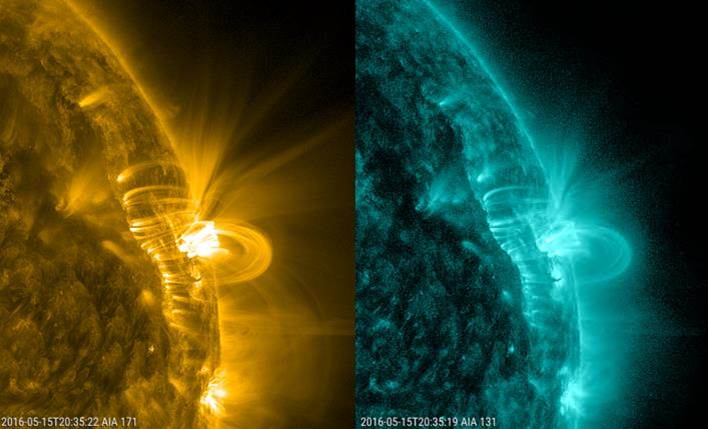
Data Homogenisation workshop in Brussels
On April 26-27, the Royal Observatory of Belgium was the venue of a workshop jointly organized by ROB, RMI and STCE. The acronym GNSS4SWEC of this European COST Action ES1206 stands for for “Advanced Global Navigation Satellite Systems tropospheric products for monitoring Severe Weather Events and Climate”.
In the project, long time series of Integrated Water Vapour (IWV) are retrieved from continuously observing permanent GNSS stations located world-wide, and exploited to compare the time variability with climate model outputs, satellite retrievals of IWV and radiosonde measurements. However, the calculated trends are affected by site-specific inhomogeneities like instrumental changes, changing operation procedures, etc. These changes are sometimes documented in the metadata, but not always. Therefore, a homogenization of the time series, consisting of the identification of the relevant changes, their validation, and the correction of the resulting offsets, is needed.
As within the COST Action different groups were already working on this issue, we organized in Brussels a topical workshop on homogenization of IWV time series to proceed in a close collaboration. As homogenization of temperature time series for climate was already the subject of a previous COST action, we also invited an expert from this COST Action (ES0601), so that he could share his experience from this community with ours. At the workshop, the different groups presented the methodology and statistical tools they used and the first results of identified “break points” for a common, reference worldwide dataset (IWV time series from about 120 GNSS stations located worldwide, homogeneously reprocessed, with at least 15 years of raw data) were shown. We also agreed to produce a synthetic dataset, with properties similar to our reference dataset, but with known timestamps of generated inhomogeneities. This synthetic dataset will be a very valuable tool to test the different homogenization algorithms that are in use in our community. ROB and RMI also formulated a standardize exchange format proposal, welcomed by the community. At the end, we would like to provide the whole scientific community with a screened, homogenized global dataset of 15+ years water vapour time series, in a standardised exchange format, which could be used to validate both satellite retrievals as the climate model output.
The workshop was attended by 12 participants from 8 different European countries and there was really a very good, collaborative spirit and high willingness to achieve the above mentioned goals. The workshop dinner at a typical Brussels restaurant, with a large selection of Belgian beers, also contributed to the nice atmosphere!
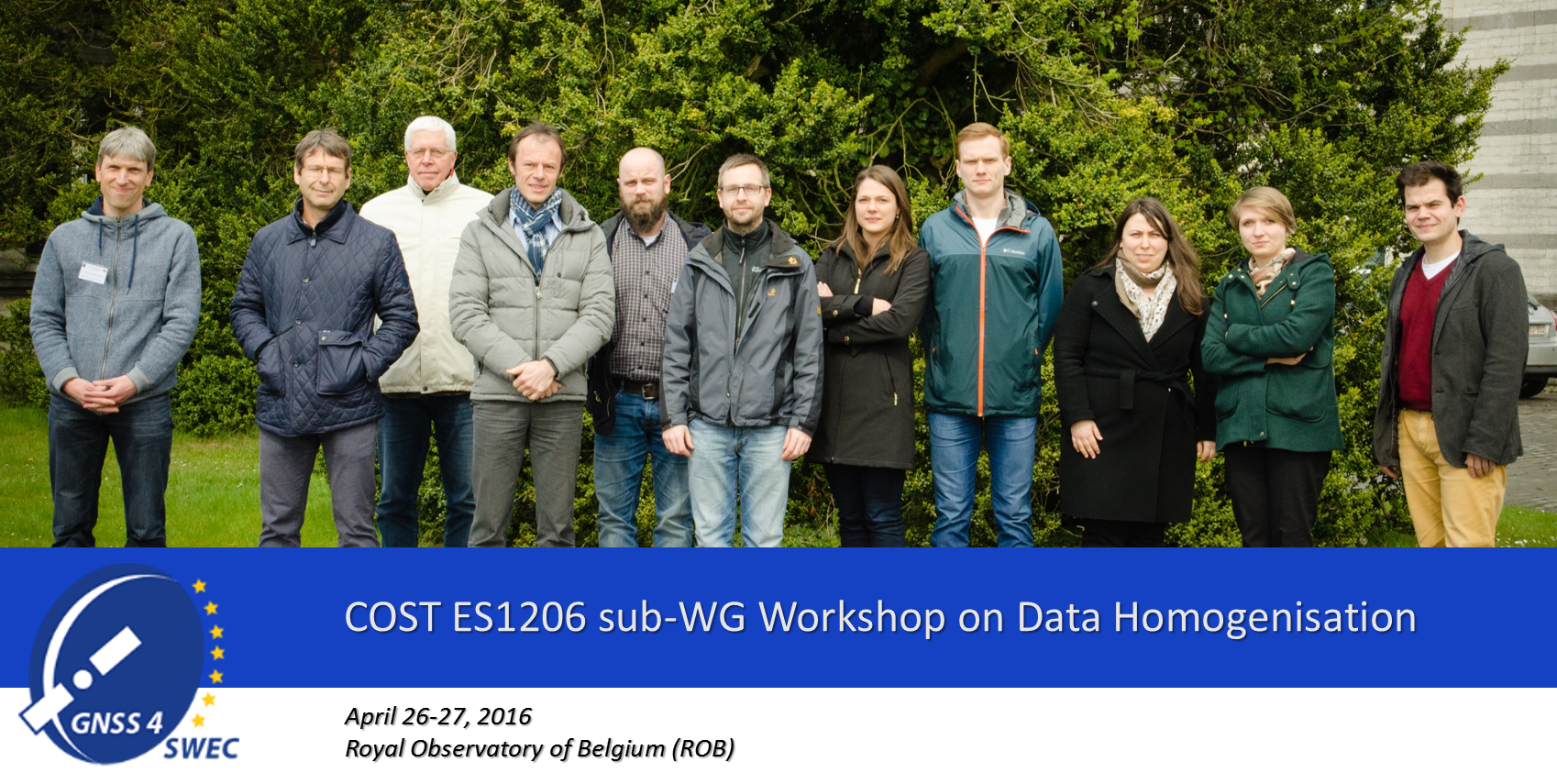
PROBA2 Observations (9 May 2016 - 15 May 2016)
Solar Activity
Solar flare activity fluctuated between very low and low during the week.
In order to view the activity of this week in more detail, we suggest to go to the following website from which all the daily (normal and difference) movies can be accessed:
http://proba2.oma.be/ssa
This page also lists the recorded flaring events.
A weekly overview movie can be found here (SWAP week 320).
http://proba2.oma.be/swap/data/mpg/movies/weekly_movies/weekly_movie_2016_05_09.mp4
Details about some of this week's events, can be found further below.
Monday May 09
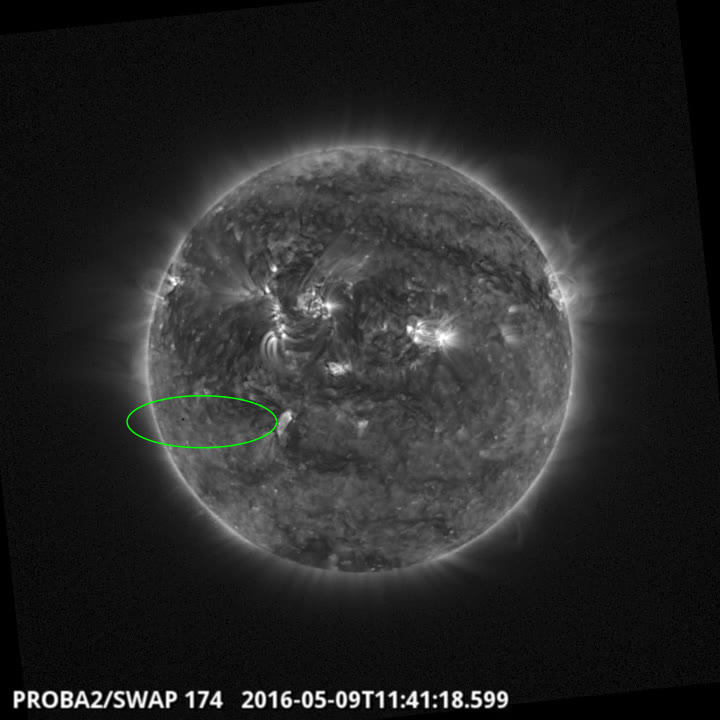
Mercury was seen by SWAP as it crossed the Sun between 11:00 and 19:00 UT on 2016 May 09
Find a movie of the events here (SWAP movie)
http://proba2.oma.be/swap/data/mpg/movies/20160509_swap_movie.mp4
Wednesday May 11
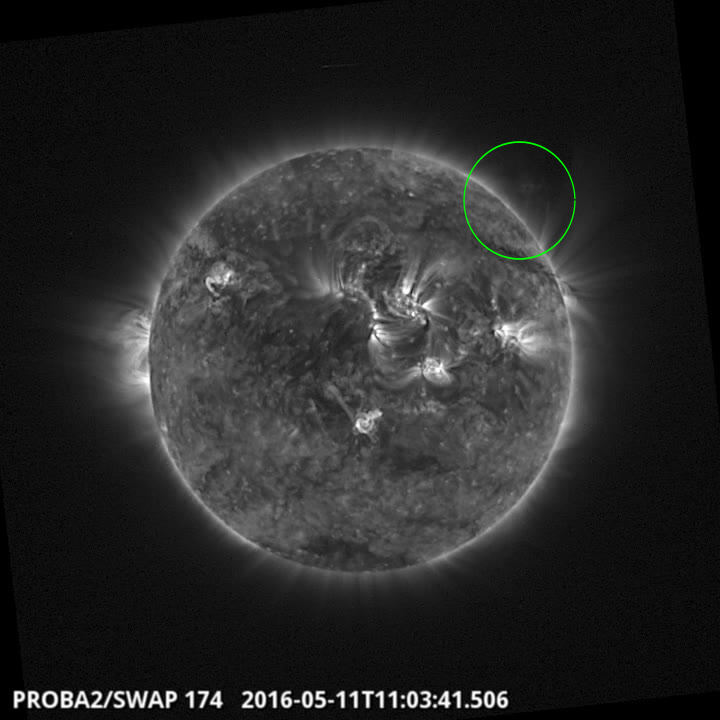
An eruption was observed by SWAP in the NorthWest limb of the Sun at 11:05 UT on 2016 May 11
Find a movie of the events here (SWAP movie)
http://proba2.oma.be/swap/data/mpg/movies/20160511_swap_movie.mp4
Sunday May 15
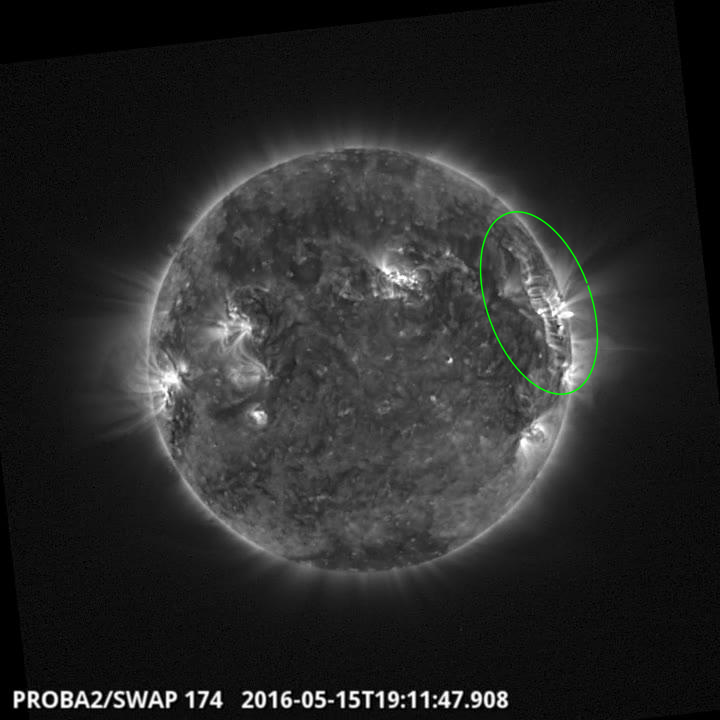
The formation of arcade loops was observed by SWAP on the west limb of the Sun at 19:11 UT
on 2016 May 15
Find a movie of the events here (SWAP movie)
http://proba2.oma.be/swap/data/mpg/movies/20160515_swap_movie.mp4
Review of solar activity
Only B-class flares were observed the 1st part of this week. During the 2nd part, solar activity slightly increased (11 C-class flares were observed by GOES).
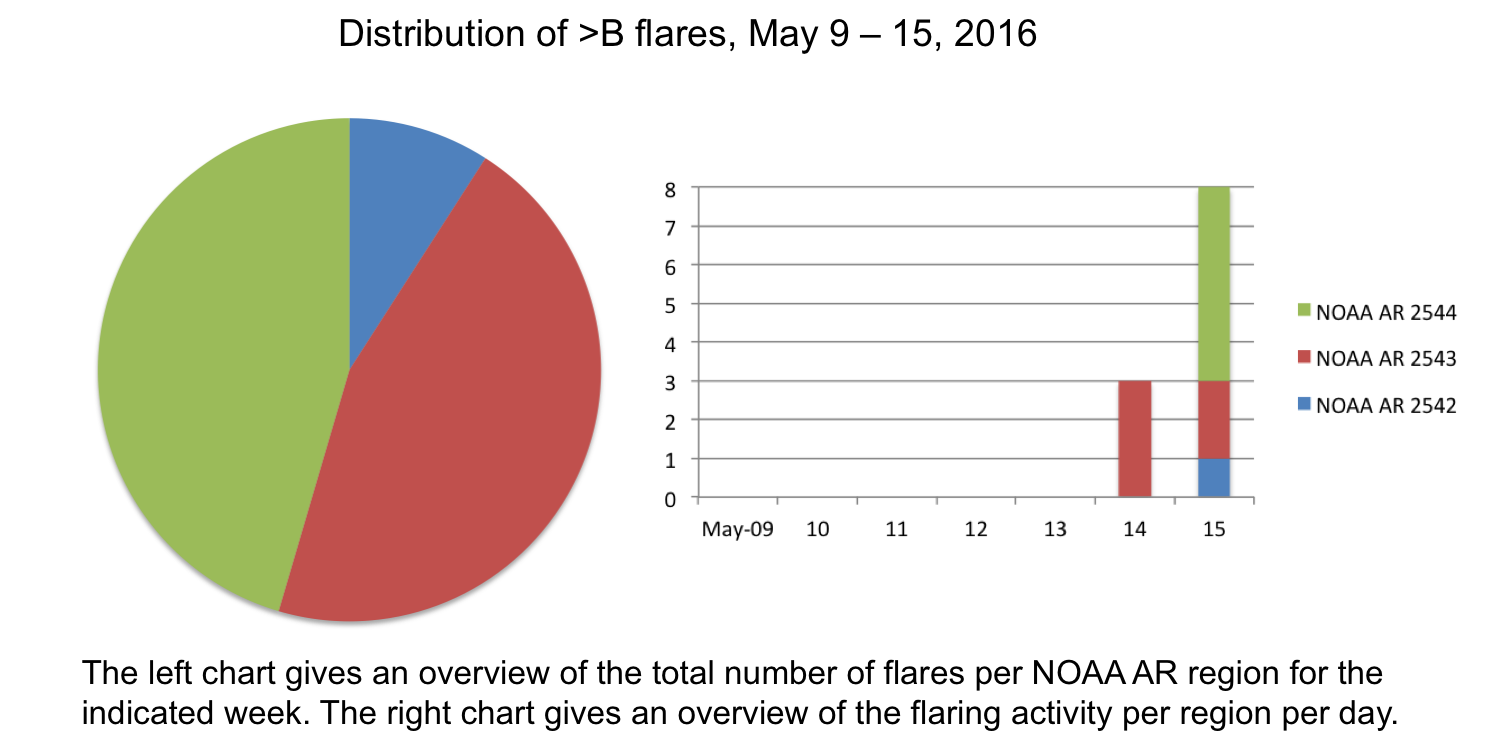
The strongest flare reported was the impulsive C7.4 flare (peaked at 11:34 UT) on May 14, which originated from the NOAA Active Region (NOAA 2543). Another long duration C3.2 flare was observed on May 15 (x-ray flux peak at 16:03 UT, source NOAA 2542) at the NW limb. The flare was associated with a filament eruption, a partial frontsided halo CME and a minor increase of the proton flux level at Earth. It was was first seen in the SOHO/LASCO C2 field of view at 16:00 UT on May 15, had an angular width of about 160 degrees and projected speed of about 570 km/s (as reported by the CACTUS software). This CME was the only significant CME observed this week.
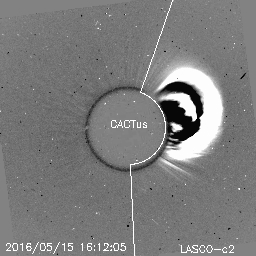
The International Sunspot Number
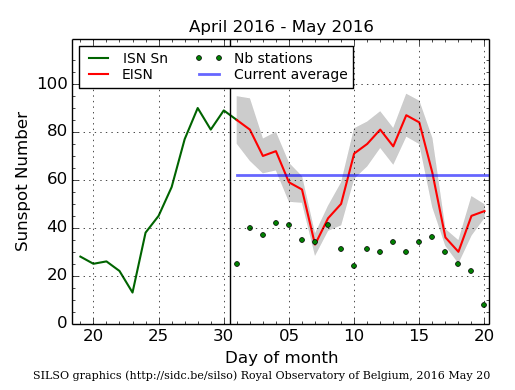
The daily Estimated International Sunspot Number (EISN, red curve with shaded error) derived by a simplified method from real-time data from the worldwide SILSO network. It extends the official Sunspot Number from the full processing of the preceding month (green line). The plot shows the last 30 days (about one solar rotation). The horizontal blue line shows the current monthly average, while the green dots give the number of stations included in the calculation of the EISN for each day.
Review of geomagnetic activity
Solar wind
The 1st part of the week, the solar wind was decaying after the influence of a negative coronal hole. The solar wind speed decreased till approximately 320 km/s. The total magnetic field strength magnitude decreased till approximately 4-5 nT, while the Bz component was fluctuating around zero.
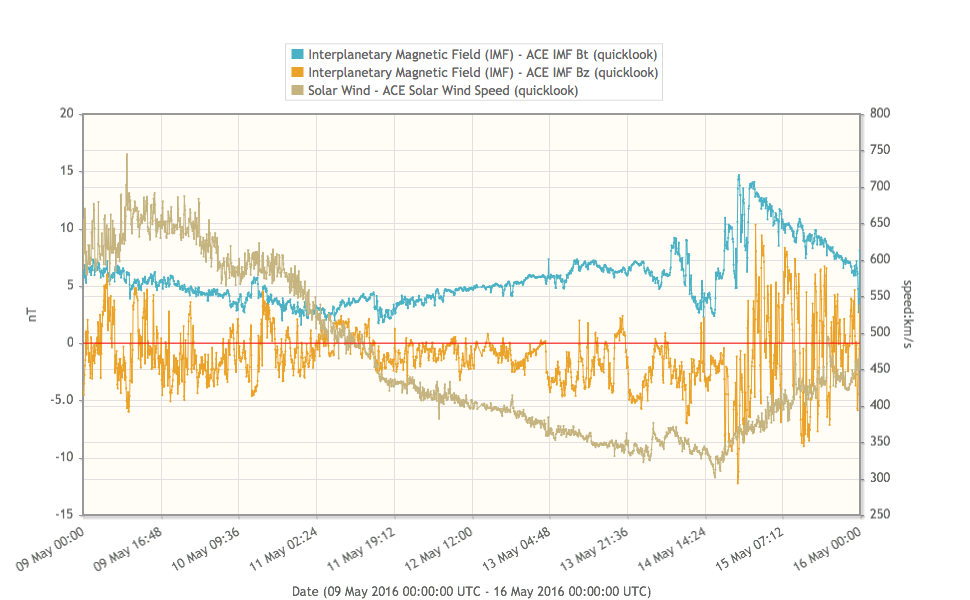
May 14, the Earth crossed the sector boundary going from the sector with an inward (relative to the Sun) Interplanetary Magnetic Field to outward IMF. The Phi angle rotated from values between 270° and 360° to values between 90° and 180°.
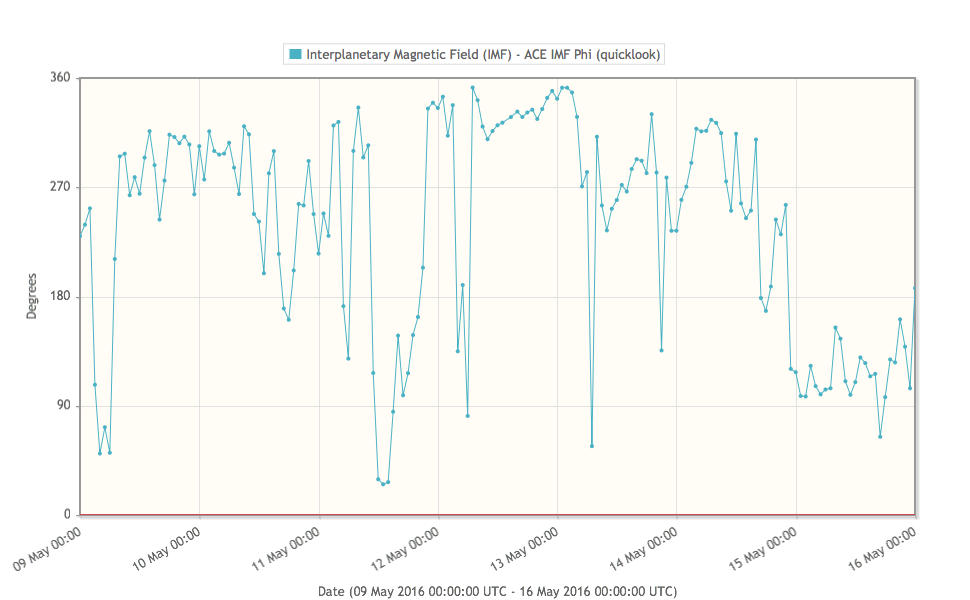
The solar wind parameters were affected. The solar wind speed increased from approximately 320 km/s till 500 km/s. The total magnetic field strength in solar wind increased till approximately 12-13 nT, while Bz component of the magnetic field fluctuated between -10 nT and 10 nT approximately.
Geomagnetic consequences
The week started with a geomagnetic storm, from May 08 and lasting for more than 24 hours. During the geomagnetic storm, the planetary K index reported by NOAA was never below 5. In the early morning and late night on May 08 NOAA reported Kp=7, Dourbes K=5.
The second part of the week, NOAA Kp and Dourbes K was below 4.
Review of ionospheric activity (9 May 2016 - 15 May 2016)
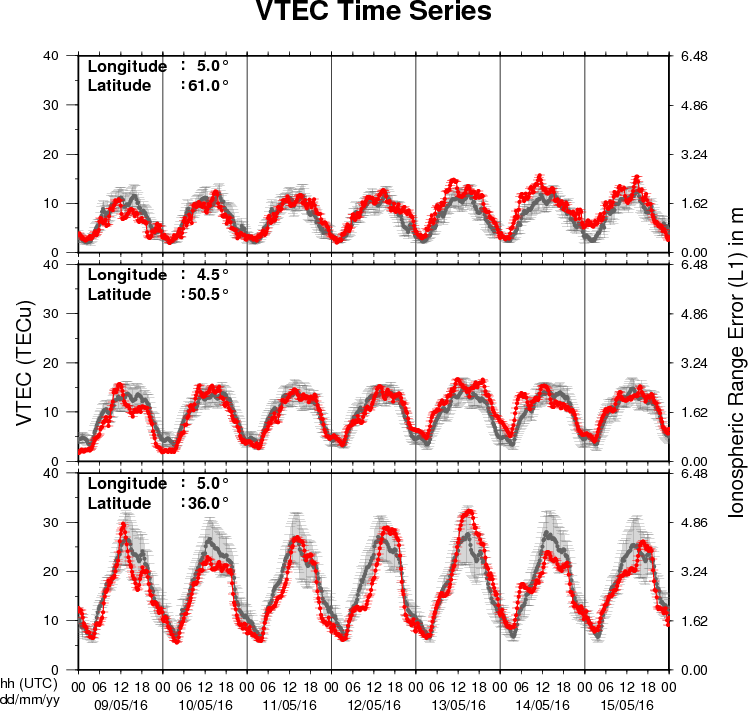
The figure shows the time evolution of the Vertical Total Electron Content (VTEC) (in red) during the last week at three locations:
a) in the northern part of Europe(N61°, 5°E)
b) above Brussels(N50.5°, 4.5°E)
c) in the southern part of Europe(N36°, 5°E)
This figure also shows (in grey) the normal ionospheric behaviour expected based on the median VTEC from the 15 previous days.
The VTEC is expressed in TECu (with TECu=10^16 electrons per square meter) and is directly related to the signal propagation delay due to the ionosphere (in figure: delay on GPS L1 frequency).
The Sun's radiation ionizes the Earth's upper atmosphere, the ionosphere, located from about 60km to 1000km above the Earth's surface.The ionization process in the ionosphere produces ions and free electrons. These electrons perturb the propagation of the GNSS (Global Navigation Satellite System) signals by inducing a so-called ionospheric delay.
See http://stce.be/newsletter/GNSS_final.pdf for some more explanations ; for detailed information, see http://gnss.be/ionosphere_tutorial.php
Future Events
For more details, see http://www.spaceweather.eu/en/event/future
Space Weather REDI Bootcamp
Start : 2016-06-07 - End : 2016-06-17
SW REDI summer Bootcamp is a two-week free training in space
weather, with the first week focusing on the fundamentals of space
weather and the second week on intensive forecaster training, with
alternative opportunities to discuss research topics with the CCMC
and NASA GSFC scientists.
The program is ideal for undergraduate and graduate students
interested in space weather forecasting or in space weather related
research but is also beneficial for scientists, engineers,
educators, mission operators, competitive high school students and
all others seeking to gain some basic knowledge regarding space
weather.
Website:
http://ccmc.gsfc.nasa.gov/support/SWREDI/bootcamp/
The Scientific Foundation of Space Weather
Start : 2016-06-27 - End : 2016-07-01
Website:
http://www.issibern.ch/program/workshops.html
Global Modelling of the Space Weather Chain in Helsinki, Finland
Start : 2016-10-24 - End : 2016-10-28
This event brings together solar, heliospheric, magnetospheric,
and ionospheric communities to discuss the current state and future
challenges in global modelling of the entire space weather chain.
Major developments in forecasting space weather, and understanding
the effects of solar eruptions requires increased communication and
collaboration of these often rather distinct communities. We
welcome submissions from these modelling communities and also
synergetic studies utilising both observations and numerical
models.
Website:
https://pnst.ias.u-psud.fr/sites/pnst/files/global_modelling_space_weather_oct2016.pdf
Solar Orbiter Workshop 7: Exploring the solar environs in Granada, Spain
Start : 2017-04-03 - End : 2017-04-06
This event will be hosted by the Instituto de Astrofisica de
Andalucia - CSIC. Please mind that on April 7th the 20th SWT
meeting will take place at the same venue.
Website: Unkown
New documents in the European Space Weather Portal Repository
See http://www.spaceweather.eu/en/repository
STCE Annual Report 2014
The STCE Annual Report 2014 is a compilation of the activities done in 2014 within the frame of the Solar-Terrestrial Centre of Excellence (STCE). This report continues the style from the previous editions. Hence, as it is targeting a more general public, it presents only a selection of the 2014-activities in easy-to-digest summaries. These summaries emphasize the intense collaboration between the institutes at the Space Pole, as well as with our external partners. We hope you enjoy this report, which features articles on solar and space weather activity, the Open Doors at the Space Pole, the 11th European Space Weather Week, helmet streamers, a new solar coronagraph, total solar irradiance, the Belgian ALC network, SPENVIS-NG, and much more... Happy reading!
http://www.spaceweather.eu/en/repository/show?id=601
